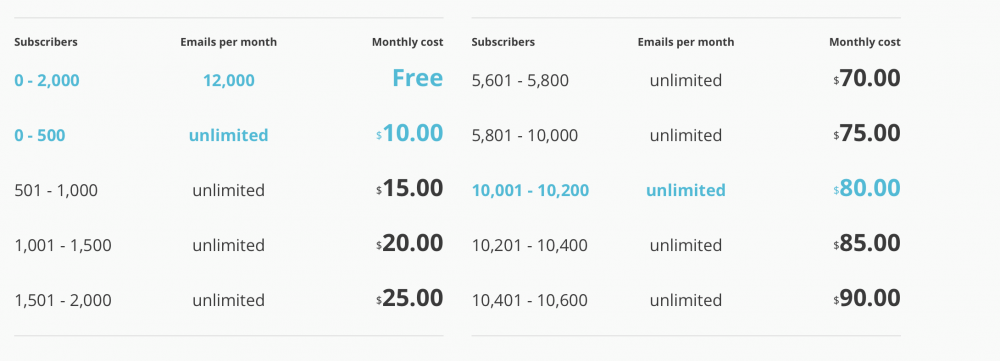Compared to the mighty MailChimp, GetResponse might seem like a bit of an underdog. But take a closer look and things are hardly that one-sided.
A quick Google search of any term relating to email marketing providers will pull up a raft of positive and negative reviews for every bit of software. The trick is to understand what each one does best, and how important that is to your site.
Ease of Use
Prior to 2012, building emails in MailChimp was a bit of a nightmare for non-techies. Since then they’ve introduced a WYSIWYG editor that works almost all of the time, although things do occasionally get messed up when you send a test email, and it’s a snap to drag and drop elements into an email.
Because they’re currently using the tagline “The world’s easiest email marketing”, you would probably assume that GetResponse also offers a drag and drop editor. And you’d be absolutely right. Like MailChimp, they offer a bunch of pre-made templates that you can customize to your heart’s content.
MailChimp is much more user-friendly than it used to be but GetResponse wins here because it passes ‘the Grandma test’; Most newbie marketers or elderly people could sit down and start using GetResponse without any problems.
Winner: GetResponse
Landing Pages/Signup Forms
MailChimp has an embedded form creator that’s very developer friendly; you can select from Classic, Super Slim or Naked and tweak the code yourself. Its signup forms are a little more basic, and not so easy to customize for non-techies.
GetResponse, on the other hand, offers the same drag and drop functionality as they do in emails for creating landing pages and signup forms. This is great for marketers or business owners who don’t do much in the way of coding, as the emphasis is firmly on the visual.
The addition of aesthetically pleasing landing pages to GetResponse’s repertoire puts it ahead of MailChimp, which lacks a comparable alternative, here.
Winner: GetResponse
Integrations
Both platforms have numerous integrations with other apps. MailChimp has hundreds of integrations with just about any app you want to use. GetResponse also supports many integrations with leading apps so both platforms give a complete solution when it comes to integrations with E-commerce, CMS and CRM platforms.
Both platforms cover 99% of the apps you want to integrate with, and if you can’t find the app you’re looking for, you can try Zapier to mediate the integration. GetResponse and MailChimp integrate with all the important apps for marketers like SalesForce, Magento, WordPress, Joomla and you name it.
Winner: Tie
Support
MailChimp only offers email support, which is often perceived as a big negative. In practice, you might never need anything beyond their comprehensive self-service knowledge base, but there are a few horror stories online about delayed responses or incidents during support downtime on public holidays.
Offering email, phone and live chat support, GetResponse definitely has the edge here. In an ideal world, you’ll never need support but it’s always good to know that it’s there if you need it.
Winner: GetResponse
Blacklisting
This might not be relevant to you but, if it is, it’s best you find out now before it’s too late. MailChimp is very skittish when it comes to affiliate links. Include affiliate links from any of the merchants on their list of prohibited sellers and you’ll get banned.
You also risk a ban if you hit a certain number of complaints, which is pretty easy to do if you buy in an email list. Couple that with the fact that MailChimp doesn’t have the quickest support and you could be looking at a few days without any marketing emails.
If all you’re doing is sending typical newsletters to people who have opted in at your website, the above won’t be a big concern. But if you do a little more than that, GetResponse’s more liberal approach to affiliate marketing and list management might suit you better.
Winner: Tie
Pricing
MailChimp’s ‘Free Forever’ plan, which allows you to send 12,000 emails per month to up to 2,000 subscribers certainly wins it some points. But it doesn’t automatically mean that they win the war.
Based on 5,000 subscribers, you’d have to pay $50 per month to use MailChimp and $45 per month (or $36.90 if you pay annually) to use GetResponse. For 100,000 subscribers you’d be looking at $475 for MailChimp or $450 for GetResponse ($369 when paying annually).


Winner: MailChimp for small lists, GetResponse for big lists.
While it’s true that price isn’t everything, paying upfront for an annual GetResponse account can result in a nice little saving that you can funnel elsewhere in your marketing budget.
Final Thoughts
Just a quick glance at their respective websites gives you a bit of insight into the markets they’re trying to cater for. With a headline that reads ‘Send Better Email’ it’s no surprise that MailChimp focuses most of their effort on their email creator, with support, signup forms etc. taking—to a certain extent—something of a backseat.
Meanwhile, GetResponse’s ‘World’s Easiest Email Marketing’ headline reaffirms the idea that the software is designed to not only be easy to use for non-technical types, but provide visual elements like form templates and comprehensive support in addition to their core email offering.
In terms of features like autoresponders, segmentation and A/B testing (you can grab some great email split testing tips here), you’ll find all of them in both MailChimp and GetResponse. But, with minor details putting GetResponse a hair above MailChimp in all of the above categories, GetResponse does have an edge over MailChimp.
There are free trials available for each package, so there’s no harm in taking each of them for a spin, but my guess is that based on the above review you’ll probably already be leaning towards one or the other.
